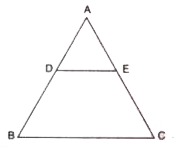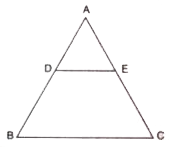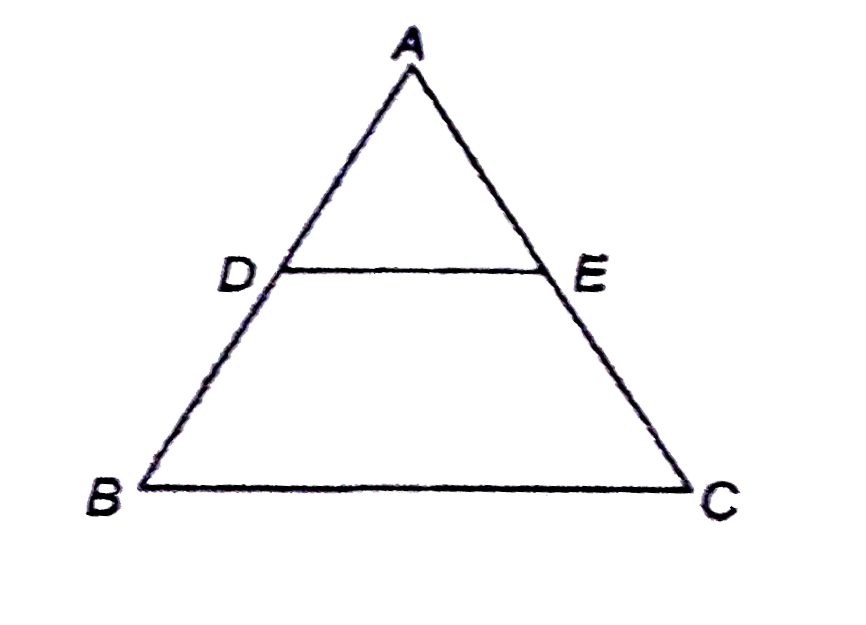In ΔABC,D and E are the points on sides AB and AC respectively.
Find whether DE || BC, if :
AB = 6-3 cm, EC = 11:0 cm, AD = 0.8 cm and AE = 1.6 cm.
The correct Answer is:Yes
To determine whether line segment DE is parallel to line segment BC in triangle ABC, we can use the properties of similar triangles and the converse of the midpoint theorem. Here’s the step-by-step solution:
Step 1: Identify the given values
We have the following measurements:
- AB = 6.3 cm
- EC = 11 cm
- AD = 0.8 cm
- AE = 1.6 cm
Step 2: Calculate the length of BD
Since D is a point on AB, we can find the length of BD using the formula:
BD=AB−AD
Substituting the known values:
BD=6.3cm−0.8cm=5.5cm
Step 3: Set up the ratio of segments
We need to check the ratios of the segments:
AEECandADBD
Calculating the ratio of AE to EC:
AEEC=1.6cm11cm
Calculating the ratio of AD to BD:
ADBD=0.8cm5.5cm
Step 4: Simplify the ratios
Now we simplify both ratios:
1. For AEEC:
1.611
This can be simplified to:
1.6÷1.611÷1.6=16.875
2. For ADBD:
0.85.5
This can be simplified to:
0.8÷0.85.5÷0.8=16.875
Step 5: Compare the ratios
Since both ratios are equal:
AEEC=ADBD
Step 6: Conclusion
By the converse of the midpoint theorem, if the ratios of the segments are equal, then DE is parallel to BC. Hence, we conclude that:
DE is parallel to BC.
---
We have the following measurements:
- AB = 6.3 cm
- EC = 11 cm
- AD = 0.8 cm
- AE = 1.6 cm
Since D is a point on AB, we can find the length of BD using the formula:
BD=AB−AD
Substituting the known values:
BD=6.3cm−0.8cm=5.5cm
We need to check the ratios of the segments:
AEECandADBD
AEEC=1.6cm11cm
ADBD=0.8cm5.5cm
Now we simplify both ratios:
1. For AEEC:
1.611
This can be simplified to:
1.6÷1.611÷1.6=16.875
0.85.5
This can be simplified to:
0.8÷0.85.5÷0.8=16.875
Since both ratios are equal:
AEEC=ADBD
By the converse of the midpoint theorem, if the ratios of the segments are equal, then DE is parallel to BC. Hence, we conclude that:
DE is parallel to BC.
Topper's Solved these Questions
- BOOK - ICSECHAPTER - SIMILARITY (WITH APPLICATIONS TO MAPS AND MODELS)EXERCISE - EXERCISE 15(C)24videos
SIMILARITY (WITH APPLICATIONS TO MAPS AND MODELS)
- BOOK - ICSECHAPTER - SIMILARITY (WITH APPLICATIONS TO MAPS AND MODELS)EXERCISE - EXERCISE 15(D)18videos
SIMILARITY (WITH APPLICATIONS TO MAPS AND MODELS)
- BOOK - ICSECHAPTER - SIMILARITY (WITH APPLICATIONS TO MAPS AND MODELS)EXERCISE - EXERCISE 15(A)48videos
SIMILARITY (WITH APPLICATIONS TO MAPS AND MODELS)
- BOOK - ICSECHAPTER - SIMILARITY EXERCISE - MULTIPLE CHOICE QUESTIONS (COMPETENCY BASED QUESTIONS)10videos
SIMILARITY
- BOOK - ICSECHAPTER - SOLVING (SIMPLE) PROBLEMS (BASED ON QUADRATIC EQUATIONS)EXERCISE - Exercise 6(e )18videos
SOLVING (SIMPLE) PROBLEMS (BASED ON QUADRATIC EQUATIONS)
Similar Questions
In ΔABC,D and E are the points on sides AB and AC respectively.
Find whether DE || BC, if :
AB = 9 cm, AD = 4 cm, AE = 6 cm and EC = 7.5 cm.View SolutionIn ΔABC, D and E are points on the sides AB and AC respectively. Find whether DE//BC, if :

AD=3cm, BD=4.5cm,AE=4cm and AC=10cmView SolutionIn ΔABC, D and E are points on the sides AB and AC respectively. Find whether DE//BC, if :

AD=7cm, BD=45cm,AE=35cm and CE=56cmView SolutionIn ΔABC,D and E are points on the sides AB and AC respectively. Find whether DE||BC if
(i) AD= 3cm , BD = 4.5cm, AE = 4cm, AC= 10cm
(ii) AB=7 cm , BD = 4.5cm, AE = 3.5 cm, CE= 5.6cm.
 View Solution
View SolutionIf P and Q are points on the sides AB and AC respeactively of △ABC, if PQ||BC,l AP= 2 cm , AB = 6 cm and AC= 9 cm find AQ.
View SolutionIn ΔABC, perpendiculars AP and CQ are droped from vertices A and C on opposite sides BC and AB, respectively. If AB=10cm,BC=16cm,AP=8.8cm, find PQ .
View SolutionConstruct a ΔABC such
BC=6cm,CA=4cmandAB=3.5cmView SolutionX and Y are points on the sides AB and AC respectively of a triangle ABC such that AX/AB=1/4, AY = 2 cm and YC = 6 cm. Find whether XY || BC or not
View SolutionConstruct a ΔABC, when AB = 6.0 cm, BC = 8.0 cm, AC = 7.5 cm.
View SolutionConstruct a ΔABC with sides AB = 6 cm, BC = 5.2 cm and AC = 4.6 cm.
View Solution

